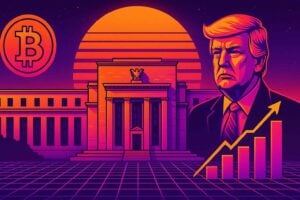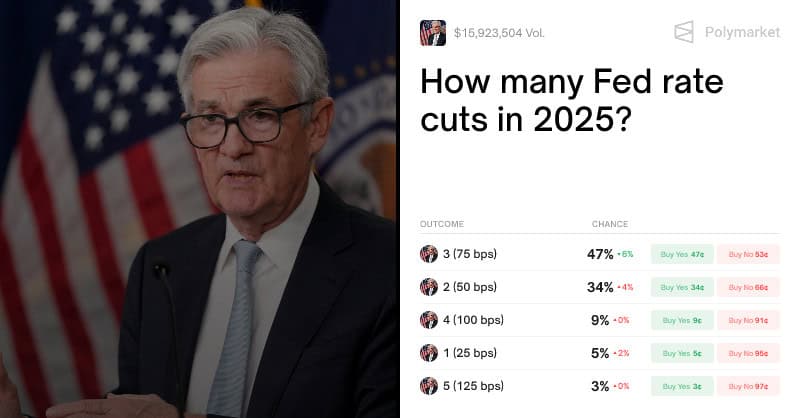The Fed Cuts Rates by 25bps, Bitcoin Steady For Now

A Labor Department revision revealed 911,000 fewer jobs were created over the past year than previously reported—basically a statistical gut punch to the “strong labor market” narrative. Combine that with sluggish growth signals and a creeping sense of slowdown, and the Fed was boxed in. “Uncertainty about the economic outlook remains elevated,” the central bank conceded in its statement—bureaucratic-speak for we’re worried.
Inflation vs. Jobs: The Balancing Act
Cutting rates with inflation at 2.9% (still above the Fed’s sacred 2% target) is no small gamble. But the central bank’s dual mandate—stable prices and maximum employment—forced its hand. Interestingly, newly installed governor Stephen Miran, Trump’s pick, dissented, calling for a 0.50% cut. His view? Go bigger, faster. Other hawkish members like Michelle Bowman and Christopher Waller, who previously opposed cuts, begrudgingly agreed that a quarter-point was “enough for now.”
Bitcoin, Ethereum, and the “Priced In” Trade
Crypto markets barely twitched. Bitcoin traded just north of $116,000, a rounding-error move of 0.2% over the previous hours, according to CoinGecko. Ethereum sat flat around $4,501. That’s because markets had already priced in this cut weeks ago—the CME’s FedWatch tool put the odds of a reduction at 96% heading into the meeting. Traders were more interested in the tea leaves of Powell’s press conference and the Fed’s updated economic projections, which now signal two more cuts possible before year’s end.

Bitcoin briefly topped $117,000 before pulling back, Source: BNC
Politics, Power Plays, and Gold at Record Highs
The rate cut didn’t happen in a vacuum. Trump has been at war with Powell’s Fed for months, accusing it of dragging its feet and threatening to replace governors with his own dovish loyalists. He just installed Miran to finish out a short term, and even tried (unsuccessfully) to oust Governor Lisa Cook—who, ironically, isn’t considered especially hawkish. A federal appeals court blocked that move, underscoring how messy the White House-Fed relationship has become.
Polymarket is now predicting further rate cuts to come this year.

Two more rates cuts are predicted this year, Source: Polymarket
Meanwhile, safe-haven buyers are voting with their wallets. Gold surged to a record $3,730 this week, up more than 10% in a month as investors hedge against both inflation and Trump-era chaos. If Bitcoin is supposed to be “digital gold,” it’s not showing it—at least not yet.
This cut was expected, priced in, and, frankly, underwhelming in immediate market terms. The real drama lies ahead: whether Powell signals further easing, whether Trump keeps meddling, and whether investors decide Bitcoin deserves to trade more like gold in this uncertain environment.
You May Also Like

Trading time: Tonight, the US GDP and the upcoming non-farm data will become the market focus. Institutions are bullish on BTC to $120,000 in the second quarter.

Crypto execs met with US lawmakers to discuss Bitcoin reserve, market structure bills
Lawmakers in the US House of Representatives and Senate met with cryptocurrency industry leaders in three separate roundtable events this week. Members of the US Congress met with key figures in the cryptocurrency industry to discuss issues and potential laws related to the establishment of a strategic Bitcoin reserve and a market structure.On Tuesday, a group of lawmakers that included Alaska Representative Nick Begich and Ohio Senator Bernie Moreno met with Strategy co-founder Michael Saylor and others in a roundtable event regarding the BITCOIN Act, a bill to establish a strategic Bitcoin (BTC) reserve. The discussion was hosted by the advocacy organization Digital Chamber and its affiliates, the Digital Power Network and Bitcoin Treasury Council.“Legislators and the executives at yesterday’s roundtable agree, there is a need [for] a Strategic Bitcoin Reserve law to ensure its longevity for America’s financial future,” Hailey Miller, director of government affairs and public policy at Digital Power Network, told Cointelegraph. “Most attendees are looking for next steps, which may mean including the SBR within the broader policy frameworks already advancing.“Read more
